1. There is no requirement of reactive power at the converter station of a HVDC link.
a) True
b) False
Explanation: There is requirement of reactive power due to phase shift between fundamental as current and voltage and commutation process.
2. _______ polarity is preferred on OH lines due to less radio interference.
a) Negative
b) Positive
c) Ground
d) Any of the mentioned
Explanation: Negative polarity is preferred on overhead lines
3. Shunt admittance of a transmission line comprises of ______
a) capacitance with conductance
b) capacitance with inductance
c) resistance with inductance
d) capacitance with susceptance
Explanation: Shunt admittance is capacitance with conductance in the branch.
4. Conductance is the result of the leakage over the surface of insulators.
a) True
b) False
Explanation: Conductance comes into the picture due to the leakage current over the conductor’s surface.
5. Charging current in the transmission line is _______________
a) drawn at open as well as closed end of the transmission line
b) drawn at closed end of the transmission line
c) drawn at open end of the transmission line
d) drawn at the shunt capacitance at closed end of transmission line.
Explanation: Charging current in transmission line is drawn even when the far end of the TL is open.
6. A three phase 50 Hz transmission line has flat horizontal spacing with 3.5 m between adjacent conductors. The conductors are No. 2/0 hard drawn copper (outside diameter = 1.05cm). The voltage f the line is 110 kV. The capacitance to neutral per kilometre of line is
a) 0.00826 μF/km
b) 0.0826 μF/km
c) 0.01652 μF/km
d) 0.1652 μF/km
Explanation:
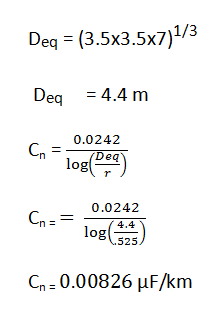
7. A three phase 50 Hz transmission line has flat horizontal spacing with 3.5 m between adjacent conductors. The conductors are No. 2/0 hard drawn copper (outside diameter = 1.05cm). The voltage f the line is 110 kV. The capacitive reactance to neutral per kilometre of line is ____________
a) 0.384 x 106 Ω/km to neutral
b) 0.768 x 106 Ω/km to neutral
c) 0.284 x 106 Ω/km to neutral
d) 0.642 x 106 Ω/km to neutral
Explanation:
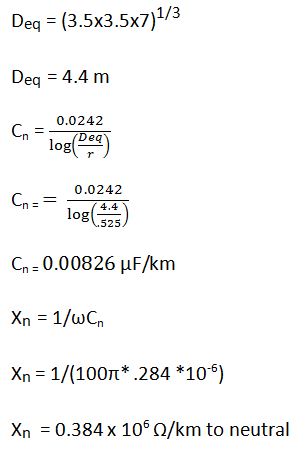
8. A three phase 50 Hz transmission line has flat horizontal spacing with 3.5 m between adjacent conductors. The conductors are No. 2/0 hard drawn copper (outside diameter = 1.05cm). The voltage f the line is 110 kV. The line charging current per km of the line is _______________
a) 0.17 A/km
b) 0.34 A/km
c) 0.24 A/km
d) 0.48 A/km
Explanation:
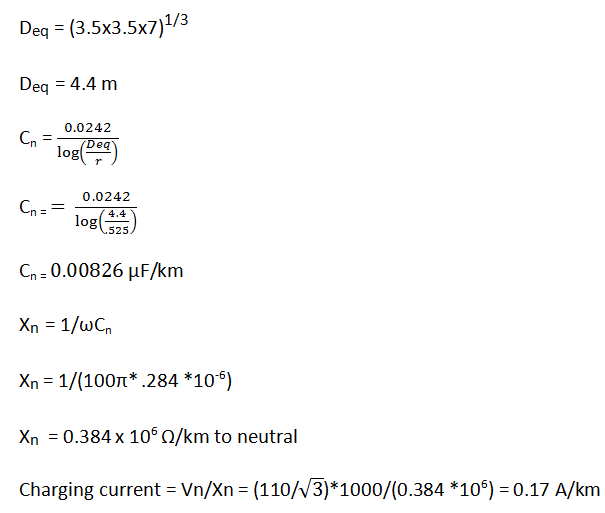
9. A three phase 50 Hz transmission line has flat horizontal spacing with 3.5 m between adjacent conductors. The conductors are No. 2/0 hard drawn copper (outside diameter = 1.05cm). The voltage f the line is 110 kV. The line charging current per conductor of the line is _____________
a) 0.085 A/km
b) 0.17 A/km
c) 0.12 A/km
d) 0.24 A/km
Explanation:
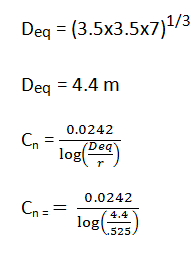
Cn = 0.00826 μF/km
Xn = 1/ωCn
Xn = 1/(100π* .284 *10-6)
Xn = 0.384 x 106 Ω/km to neutral
Charging current = Vn/Xn
Charging current = (110/√3)*1000/(0.384 *106)
Charging current = 0.17 A/km
Charging current per conductor = I/2
Charging current per conductor = 0.17/2
Charging current per conductor = 0.085 A/km.
10. A three phase 50 Hz transmission line has flat horizontal spacing with 3.5 m between adjacent conductors. The conductors are No. 2/0 hard drawn copper (outside diameter = 1.05cm). The voltage f the line is 110 kV. The reactive volt amperes generated by the line is
a) 31.4 kVAR
b) 62.8 kVAR
c) 42 kVAR
d) 56 kVAR
Explanation:
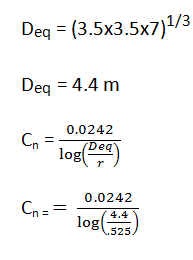
Cn = 0.00826 μF/km
Xn = 1/ωCn
Xn = 1/(100π* .284 *10-6)
Xn = 0.384 x 106 Ω/km to neutral
Reactive volt amperes generated by the line = (VL)2/Xc
Reactive volt amperes generated by the line = 31.4 kVAR.